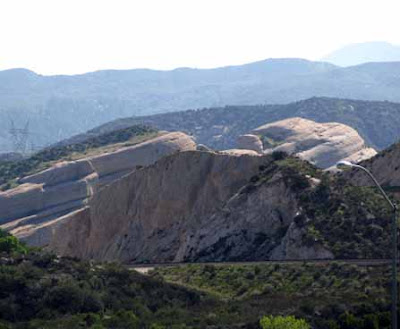After Don’s talk in the museum, we got back into the tour
bus and traveled further onto the base.
He asked the driver to stop at times to point out specific buildings, show us "The Right Stuff" movie locations, and give us a
better view of Rogers Dry Lake Bed. It’s
such a large, flat, and clear area, that astronauts can see it when
they’re in orbit over Guam, six thousands miles away (or ¼ across the
Earth).
Of course, aircraft outnumber spacecraft by a significant
margin, and everywhere we went, we saw planes parked in lots or set out on
display. After awhile, the bus driver stopped
outside the main runway, got out to check the tires for any rocks or other
debris they might have picked up, then drove the bus forward a few feet, and
performed a second inspection. Don explained that this precaution was due
to the speed at which the planes took off and landed. Imagine the damage to the aircraft, or
bystanders, that a pebble could cause, if a speeding plane rolled over it, or
the air disturbed by its passage picked it up, and flung it across the
runway. As if to reinforce this point, a
street-sweeping vehicle, capable of sucking loose debris into its vacuum,
rolled past.
As we rode along in the bus, we saw planes parked on the
tarmac, or in the hangers. Many were
fighter jets, like the new F-35 Lightning II, and older, more time-tested
models like the F-16 Fighting Falcon. We
also saw larger planes, such as the C-17 Globemaster III military
transport. We stopped by a hanger
where retired volunteers were rebuilding older airplanes, such as the F-80
Shooting Star, and a mockup of the X-15 rocket plane. One of the volunteers told us how they go about rebuilding the airplanes they’ve managed to reclaim. As amazing as it seems, they sometimes find these magnificent planes rusting away in backyards. Depending on a given plane's size and condition, they may have to close roads, and tow it along, usually at night, until they got it back to the base.
Along the runway again, Don showed us one
building he called the "Bad Comb-over" building. Apparently, it was used for Tony Stark’s
headquarters in the movie “Iron Man.” He
pointed out red painted lines on the runway, and said that anyone who crossed
them, either in a vehicle or on foot, would be punished severely, if not shot. (But they’re only painted lines, Don!) As he was a big, well-rounded man, he showed us a building he used to work in, and said that he had spent many happy
moments at its snack bar/refreshment area. Yes, good times, Don. Good times.
At one point, Don's voice rose, and he urged us to look out front. We watched as a fighter jet landed ahead of us, and slowed as it neared. Designated a
F-22 Raptor, it’s a newer fighter jet the Air Force is still working the
bugs out of. As the plane rolled past,
everyone on the bus waved, and a chill rippled down my spine. I wondered what the pilot was testing on his
fighter jet. Some new components to make
the plane more reliable, or systems designed for some other purpose? This was what Edwards Air Force Base was all
about. It wasn’t like Top Gun, where
they taught pilots how to dogfight. This
was Flight Test, where they tested out planes, parts, and systems that might
later be used by pilots in combat situations.
More Tomorrow.
Dragon Dave












